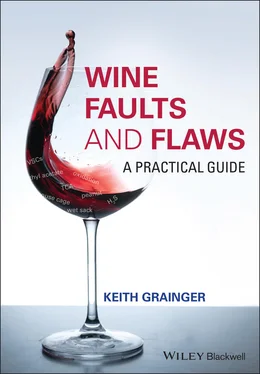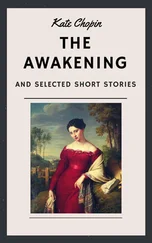Keith Grainger - Wine Faults and Flaws
Здесь есть возможность читать онлайн «Keith Grainger - Wine Faults and Flaws» — ознакомительный отрывок электронной книги совершенно бесплатно, а после прочтения отрывка купить полную версию. В некоторых случаях можно слушать аудио, скачать через торрент в формате fb2 и присутствует краткое содержание. Жанр: unrecognised, на английском языке. Описание произведения, (предисловие) а так же отзывы посетителей доступны на портале библиотеки ЛибКат.
- Название:Wine Faults and Flaws
- Автор:
- Жанр:
- Год:неизвестен
- ISBN:нет данных
- Рейтинг книги:4 / 5. Голосов: 1
-
Избранное:Добавить в избранное
- Отзывы:
-
Ваша оценка:
- 80
- 1
- 2
- 3
- 4
- 5
Wine Faults and Flaws: краткое содержание, описание и аннотация
Предлагаем к чтению аннотацию, описание, краткое содержание или предисловие (зависит от того, что написал сам автор книги «Wine Faults and Flaws»). Если вы не нашли необходимую информацию о книге — напишите в комментариях, мы постараемся отыскать её.
FLAWS
Wine Faults and Flaws: A Practical Guide
An essential guide to the faults and flaws that can affect wine
Wine Faults and Flaws — читать онлайн ознакомительный отрывок
Ниже представлен текст книги, разбитый по страницам. Система сохранения места последней прочитанной страницы, позволяет с удобством читать онлайн бесплатно книгу «Wine Faults and Flaws», без необходимости каждый раз заново искать на чём Вы остановились. Поставьте закладку, и сможете в любой момент перейти на страницу, на которой закончили чтение.
Интервал:
Закладка:
Wine tannins should be assessed and noted for both level and nature. We may assess the level on a scale that runs from low , to high . The nature of the tannins may be described as ripe/soft or conversely unripe/green/stalky . The texture of the tannins should also be noted. Tannins that are assertive, rough, and very gritty may be described as coarse , whilst those with a smooth, velvety texture as fine‐grained . Wines with high or very high levels of tannins are coarse‐textured. Those with very unripe tannins may be considered to be flawed, as will be discussed in Chapter 14.
2.7.6 Alcohol
Alcohol is the most abundant volatile compound in wine. It is detected on the palate as a warming sensation, perceived at the back of the tongue, the cheeks and in the mouth generally. The higher the level of alcohol, the more of a warm ‘glow’ will be perceived by the taster. Alcohol also gives a combination of sweet and bitter tastes, and bitterness increases with higher alcohol levels [13]. Over‐alcoholic wines will give burning sensations, and this may be considered to be a flaw (see Chapter 14). The ‘weight’ of the wine in the mouth also increases with the concentration of alcohol.
With an increase in the level of alcohol, there is a decrease in the volatility of wine aroma compounds.
The alcoholic content of light, i.e. unfortified wines, ranges from 7.5% to 16% abv (alcohol by volume). As grapes ripen, the levels of fructose and glucose increase, thus increasing the potential amount of alcohol. Generally speaking, wines from hotter climates contain more alcohol than those from cooler regions. However, the average alcohol level of wines has increased during the last two or three decades. This is due to many reasons, including changes in canopy management, growers delaying harvesting until so‐called phenolic ripeness is reached (especially as the market now demands a softer style of reds than in the past), the impact of climate change and the use of cultured, alcohol tolerant yeasts. In 1989, referring to Australian Cabernet Sauvignons, Bryce Rankine wrote in the reference work Making Good Wine : ‘A ripeness of 10°–12° Baumé (18–21.6° Brix) is usual, which results in a wine containing between about 10% and 12% alcohol by volume’ [14]. Today, any Australian Cabernet Sauvignon with less than 13% abv would be regarded as atypical – probably over‐cropped and certainly under‐ripe. Alcohol levels in white wines can range from as low 7.5% abv (e.g. some Riesling wines from Germany's Mosel region), up to 14.5% abv (e.g. some Californian Chardonnays). Red wines may range from 11% abv (e.g. some Bardolinos from Italy's Veneto region) up to 15% or more (e.g. some Chilean Cabernet Sauvignons). There is not much point in the taster attempting to estimate the actual alcoholic degree, (or the actual level of acidity) – it is the impression rather than quantification that is relevant. There are methods of removing alcohol from over‐alcoholic wines, including the use of reverse osmosis (RO) machines or spinning cone columns, but these remain controversial.
If a fortified wine is being assessed, the alcohol will be in the range of 15–22% abv. We consider whether the wine has been fortified to a low level (15–16% abv), e.g. Fino Sherry or Muscat de Beaumes de Venise, a medium level (17–19% abv), e.g. Sherries other than Fino/Manzanilla, some vin doux naturel s (VDNs), or a high level (20% abv or more), e.g. Port. The presence of the ‘hot’ aromas or palate that shows spirit tones indicate a flaw, as the spirit addition to fortified wines should be seamlessly integrated.
2.7.7 Body
Body, sometimes referred to as weight or mouthfeel, is more of a tactile than a taste sensation. It is a loose term to describe the lightness or fullness of the wine in the mouth. Body should not be confused with alcohol, although it is unlikely that a wine low in alcohol will be full‐bodied. Generally, wines from cooler climates tend to be lighter‐bodied than those from hotter areas. Certain grape varieties usually produce light‐bodied wines, whilst others make full‐bodied ones. Although it is a huge generalisation, wines made from Sauvignon Blanc or Riesling tend to be fairly light in body, whilst those made from Chardonnay or Viognier maybe medium to full‐bodied. Of red grape varieties, Pinot Noir usually produces a lighter‐bodied wine than Cabernet Sauvignon or Syrah.
The body of a wine is supported by its structure , made up of a combination of acidity, alcohol, tannin (red wines), and any sweetness. The structure may be thought of as the architecture of a wine.
2.7.8 Flavour Intensity
Flavour intensity should not be confused with body. A wine can be light‐bodied but with a very pronounced intensity of flavour, for example, a fine Riesling from Germany's Mosel region. However, as with the other aspects of style and quality, the flavour intensity of a wine will depend upon many factors in the viticulture and winemaking processes. Of particular significance is the yield in the vineyard, both per hectare and per vine. It is generally accepted that flavours of wines from high‐yielding vines are often more dilute and lack the concentration of those from vines with a low yield. However, this view has been challenged by some viticulturists including Mark Matthews, a professor of viticulture at the Robert Mondavi Institute at the University of California at Davis [15]. It should be noted that a low yield for one grape variety, e.g. Sauvignon Blanc would be considered high for another, e.g. Pinot Noir. Flavour intensity is one of the key considerations when assessing quality.
2.7.9 Flavour Characteristics
The flavour characteristics perceived on the palate may closely replicate the aromas identified on the nose, but new flavours may emerge, and some characteristics previously identified may be muted. When noting individual terms, these may be linked to known varietal characters. Table 2.6lists some of the flavours that may be perceived in white wines and the grape varieties or other wine components commonly associated with them. Table 2.7lists some of the flavours found in red wines and their associated varieties and other wine components.
Table 2.6 Some white wine flavours and the grape varieties or other wine components commonly associated with them.
| Apple | Chardonnay (cool climate), Riesling |
|---|---|
| Apricot | Riesling, Viognier |
| Asparagus | Sauvignon Blanc |
| Banana | Chardonnay (hot climate) |
| Butter | Malolactic fermentation completed |
| ‘Catty’ | Sauvignon Blanc |
| Citrus | Chardonnay (cool climate), Riesling |
| Coconut | Oak ageing |
| Cream | Malolactic fermentation completed |
| Creamy texture | Lees ageing |
| Elderflower | Sauvignon Blanc |
| Gooseberry | Sauvignon Blanc |
| Grapefruit | Chardonnay, Sémillon |
| ‘Herbaceous’ | Sauvignon Blanc |
| Herbs | Pinot Grigio |
| Honey | Chenin Blanc, Riesling, Viognier |
| Kerosene | Riesling (aged) |
| Kiwi | Pinot Grigio, Sauvignon Blanc |
| Lanolin | Sémillon |
| Lemon | Chardonnay, Pinot Grigio |
| Lime | Riesling (moderate climate), Sauvignon Blanc |
| Lychee | Gewürztraminer |
| Mandarin | Sémillon |
| Mango | Chardonnay (hot climate) |
| Melon | Chardonnay (moderate climate) |
| Nectarine | Sémillon |
| Nettles | Sauvignon Blanc |
| Nuts | Chenin Blanc, Oak ageing |
| Passion fruit | Sauvignon Blanc |
| Peach | Chardonnay (moderate climate), Riesling, Chenin Blanc |
| Pear | Chardonnay (cool climate), Pinot Grigio |
| Pepper – bell (green) | Sauvignon Blanc |
| Petrol | Riesling (aged) |
| Pineapple | Chardonnay (hot climate) |
| Roses | Gewürztraminer |
| TCP | Noble rot ( Botrytis cinerea ) |
| Toast | Oak ageing |
| Vanilla | Oak ageing (especially American oak) |
| ‘Wet wool’ | Chenin Blanc |
Table 2.7 Some red wine flavours and the grape varieties or other wine components commonly associated with them.
Читать дальшеИнтервал:
Закладка:
Похожие книги на «Wine Faults and Flaws»
Представляем Вашему вниманию похожие книги на «Wine Faults and Flaws» списком для выбора. Мы отобрали схожую по названию и смыслу литературу в надежде предоставить читателям больше вариантов отыскать новые, интересные, ещё непрочитанные произведения.
Обсуждение, отзывы о книге «Wine Faults and Flaws» и просто собственные мнения читателей. Оставьте ваши комментарии, напишите, что Вы думаете о произведении, его смысле или главных героях. Укажите что конкретно понравилось, а что нет, и почему Вы так считаете.












